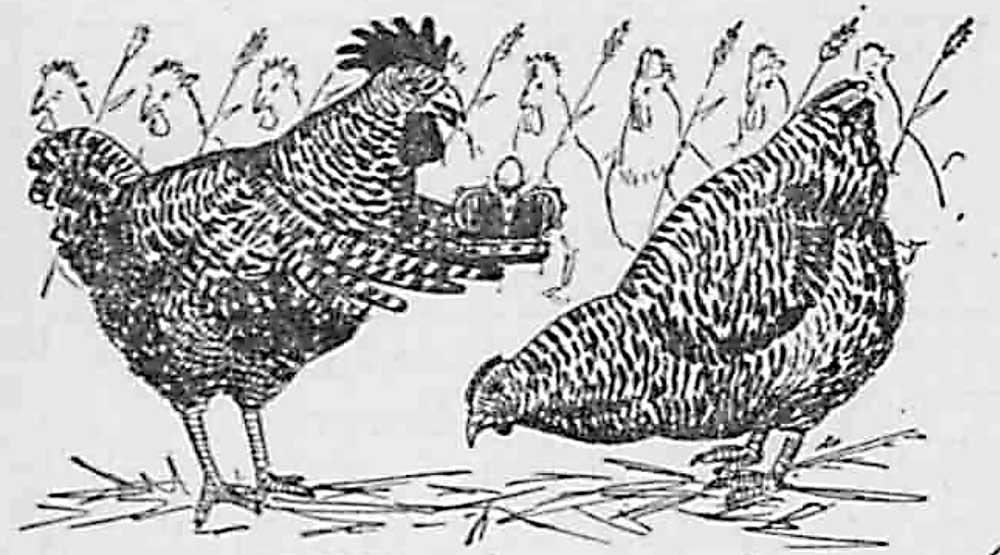Offbeat Oregon: It’s all about the genetics when it comes to eggs
Published 12:00 am Wednesday, January 5, 2022

- The Portland Morning Oregonian’s fanciful artist’s impression of what it might look like for Oregon Agricultural College’s world-record-holding hen to be crowned.
Editor’s note: Part II of the unusual story of Oregon Agricultural College Professor James Dryden’s claim that common poultry can lay more eggs than purbreds.
Trending
Oregon’s agricultural community, was noticeably unimpressed by these arguments against Professor Dryden’s claims. Obviously, farmers weren’t keeping chickens for ornamental reasons. If OAC had taken “Judge” Collier’s advice and quit telling farmers how to increase egg yields in favor of some platitudes about quality chicken coops and sanitation practices, there probably would have been a revolt.
Over the next few years, Dryden and his college moved from win to win. By 1911 it was clear that he was right about genetics and egg-laying. In December two of his chickens came within 9 percent of the world record, which at the time was 282 eggs in 12 months, held by an Ontario Agricultural College chicken. Dryden’s Chicken No. A-122, a purebred barred rock, laid 259, and Chicken A-61, a barred rock-white leghorn cross, laid 257.
The next year Dryden & Co. fixed up a rail car as a mobile poultry demonstration and toured the state with it, letting everyone see the state’s champion chicken alongside an apparently identical barred rock that laid only 44 eggs in the time A-122 laid 257. Dryden’s point was that if farmers don’t know each hen’s individual output, they can’t make good decisions about which chickens to continue feeding and which to turn into chicken soup, and the low-output layers will offset the high-output layers.
Trending
“Demonstration is a Revelation,” the Capital Journal wrote in a long sub-headline about the display. “Two Hens Looking Just Alike Show Different Records — One is a Homebody and Produces 240 Eggs, While Her Flirtatious Sister Devotes Time to Lunches, Suppers, Late Dinners and Such and Gives Up 44.”
“The poorer layer had a saucy, wear-your-hat-on-the-back-of-your-head sort of look and somehow reminded one of Mrs. Jack Cudahy,” the reporter wrote, in a reference to a famously flirty Kansas City society woman whose millionaire husband had just attempted to murder one of her male friends in a jealous rage.
“Another of the same breed, but evidently with equal-suffrage ideas about oviparity, deposited only six of the shell-covered bird seeds in 12 months.”
The following year, Dryden and his team finally clinched the world record, wringing 291 two-ounce eggs out of a chicken named C-543 in the course of the year that ended on Oct. 15, 1913. In the meantime, chicken C-521 (Lady MacDuff) was at 279 eggs and counting, with 30 more days in her 12 months; barring some kind of freak incident, the college was about to break both C-543’s record and the 300-egg barrier.
This, of course, happened, right on schedule in early November.
Newspapers around the state and beyond metaphorically threw their hats in the air.
“OREGON’S GREAT RECORD-MAKING HEN ONLY ONE OF FLOCK,” The Sunday Oregonian shouted above a photo spread covering most of Page Two. And, later, “DEVELOPMENT OF BREED OF HENS WITH SPECIAL ABILITY TO PRODUCE EGGS DRAWS WORLD’S ATTENTION TO OREGON.”
“HEN C-543 WORTH HER WEIGHT IN GOLD: Oregon Chicken is World Beater,” the Portland Journal proclaimed, following up with a glowing comment on the editorial page headlined “THE CORVALLIS WONDER.”
Well … most of the newspapers did. At least one did not.
At the Cottage Grove Leader, the coverage of Dryden’s triumph was almost whiplash-inducing. On the front page, reasonably prominently placed, was an article headlined “OREGON HEN MAKES WORLD MARK.” It was a short but straightforward account of C-543’s feat. But in the same issue, on the editorial page, under a headline reading “Pure Breeds vs. Mongrels,” editor W.C. Conner really cuts loose. And it’s this article that led Dryden to actually complain to the Leader two weeks later, prompting the newspaper’s call for his resignation.
The fascinating thing about this particular moment in the chicken battle is, up to this point it had not been entirely clear why the Leader was so intransigently opposed to Dryden’s efforts to improve chickens’ egg-laying qualities. It had quoted and supported poultry breeders, chicken-show judges, and other interested parties whose business models were threatened by the new attitude, and it stuck by them even when their position was obviously contrary to the best interests of most ordinary chicken keepers. Why?
Because, as it turned out, chicken C-521 was a cross-breed, and Conner was a eugenics fanatic, and — well, let’s let him explain: (Bear with me here, Conner’s editorial writing style was turgid and soporific even by 1910s standards.)
“The Leader would refrain from unjust criticism of any state educational institution or its management or the work of any department thereof,” the editorial begins, “but it seems to us that the highest ideals should be fostered in these institutions and all standards of excellence upheld and maintained. And while this object may generally prevail at these educational institutions, we are unable to understand wherein the management of the poultry department at OAC expect to better or advance the great poultry industry of the country by perpetually idealizing and exploiting mongrel strains and breeds of chickens, when perfection in the various standard bred fowls is what every prominent and successful breeder in the country is striving for.”
The editorial goes on to revisit “Judge” Collier’s comments from three years previously, ranting tediously that chicken race-mixing is “not supported by national or international contests and the poultry records, nor by facts, figures, or Nature’s laws.”
“The fact is,” the editorial continues, a few paragraphs later, “it would be just as reasonable to advocate the production of superior dairy herds by a conglomeration of cattle breeds, or superior horses by a mixture of Clyde, Belgian and Percheron, and so on down the line. This would mean an inevitable return in time to the razor-back hog and the inferior and mongrel breeds found a few decades ago in their native state before they were bred up to the present excellent standards by man.”
And then, finally, Conner makes his true objection to cross-bred chickens plain: He sees it as a form of miscegenation:
“Of course, you might improve the characteristics and the qualifications of the Chinese or Africans by the infusion of the white race,” he writes, “but it would be mighty hard on the Caucasians.”
Ouch. At least he didn’t use racial slurs.
Whether this exhibition of racism and enthusiasm for eugenics played as awkwardly in 1913 as it does today is very doubtful; such ideas were almost mainstream back then. But, it has to have been pretty obvious to everyone reading the Leader that its editor had become obsessed and was no longer talking any kind of sense.
The fancy-chicken breeders and county-fair judges might have been going along with him, for business reasons; but nearly every other reader must have thought the guy had flipped his wig. The local college had set a new world record and set the entire country talking about Oregon chickens, and all that seemed to matter to the Cottage Grove Leader was the purity of the chickens’ bloodstock?
In any case, as far as I have been able to learn, the Leader retreated from the field after this engagement. Eighteen months later, editor Conner sold the paper to W.H. Tyrrell, a newspaperman from Iowa; and two months after that, Tyrrell, having found that Conner had misrepresented the business’s balance sheets, merged the paper into the rival Cottage Grove Sentinel. The last issue of the Leader was published in August of 1915.
As for Dryden, in 1916 his book, Poultry Breeding and Management, was published to enormous acclaim. It became the most important chicken-farming textbook of the inter-war period. OSU’s poultry building, a classic brick structure built in 1927, was named Dryden Hall to honor him.
Today, thanks largely to Dryden’s work, the average egg-breed hen lays 200 to 250 eggs a year. The world record for egg laying is currently held by an Australian chicken, which in 1979 laid 371 eggs in 365 days.
(Sources: “Corvallis chicken sets 1913 world record,” an article by Kristine Deacon posted July 1, 2021, on the Oregon State Archives Facebook page; Poultry Breeding and Management, a book by James Dryden published in 1916 and 1920 by Orange Judd Co.; archives of Cottage Grove Leader, Cottage Grove Sentinel, Portland Morning Oregonian, Oregon Journal, Medford Mail Tribune, and Capitol Journal, 1908-1915)
“Dryden’s point was that if farmers don’t know each hen’s individual output, they can’t make good decisions about which chickens to continue feeding and which to turn into chicken soup.”








